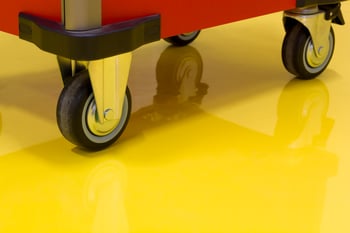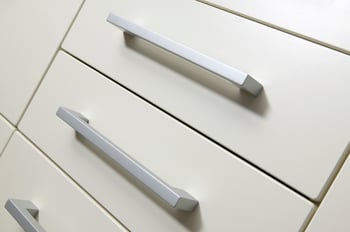When designing your portable lab bench, flexibility and mobility are likely two important qualities you’re looking for. Yet many lab managers often overlook other important components of a lab bench, from storage to the manufacturer you choose to design it.
Here are five mistakes you should avoid when designing your next portable lab bench.
1. Casters Don’t Offer Enough Support
To some, casters are just wheels that make a lab bench portable. Nothing could be farther from the truth. 
While casters do allow for the movement of a mobile workbench, they don’t serve one purpose.
Casters help determine how much weight a lab bench can hold. If your lab bench holds heavy equipment, it’s important to take into consideration that the casters are strong enough to support the bench. It can be tempting to order casters online through retail sites, but most sold through these sites are meant for office or household environments and may only hold a few hundred pounds.
In lab environments where heavy testing equipment is used, casters should have the ability to support a higher weight load capacity. In general, look for a weight load capacity of at least 1,000 pounds when using all four casters.
Casters can offer additional support that promotes a higher level of efficiency and safety in the lab as well. Other features to look for in casters include:
- Mechanisms that lock all four wheels
- Swiveling features, whether the casters are locked or unlocked
- Adjustable height options to promote better ergonomics and worker safety
While casters are often thought of as “just wheels,” overlooking the importance of them in your lab bench’s design can be a mistake that costs you in safety and efficiency.
2. Your Lab Bench Countertop Doesn’t Match Your Application
Not all labs are the same. They all have different requirements and needs based on the work that is being performed inside the lab.
An electronics lab will have different requirements than a dental lab, school lab or biological lab. One of the biggest differences in how a portable laboratory bench is designed for a particular workspace is in the material used for the countertop.
While it may make sense to choose a countertop material that is lighter in weight since the lab bench is mobile, a lighter material like laminate will often not hold up to the harsh conditions found in many labs.
If the lab bench countertop you choose isn’t designed for how you need it to perform, you could find yourself dealing with a costly mistake. So which work surface is best? It depends on different factors, such as the chemicals you use, whether exposure to moisture or water is a consistent concern, and if your lab needs protection against special hazards like electrostatic discharge which would require ESD laminate surfaces.
Both epoxy resin and phenolic resin offer high protection against bacteria, fungus, chemicals, moisture and scratches. However, if your lab operates using open flames, epoxy resin may be the better choice because it is flame retardant and can withstand continuous heat exposure above 350 degrees F.
Other options include stainless steel, which can withstand continuous heat exposure above 1500 degrees F and is highly resistant to fungus, or chemical resistant laminate, which is often used in labs where chemicals are present.
You can read more about some of your options in our article, Top 5 Materials To Consider For Your Lab Countertops.
3. Storage Options Don’t Make Sense
Portable lab benches are designed to be on the move when necessary. But if lab workers do not have easy access to the tools they need no matter where the bench is located, productivity can suffer.
tools they need no matter where the bench is located, productivity can suffer.
When evaluating your storage options, here are a few features to consider:
- Number of drawers and configuration: There are several options when it comes to how many drawers you have and how they are configured. For example, in the same amount of space you could choose four 3-inch drawers and two 6-inch drawers, or eight 3-inch drawers.
- If the drawers are ergonomically-friendly: Ergonomically-designed drawers help optimize your workspace and help prevent repeated strains to the body. Ensuring your lab bench has drawers that are easily reachable and accessible can make a major difference in the well-being of your employee. Other characteristics to look for include full extension and heavy duty roller bearing slides in the drawers.
- Safety features: In a lab where security is an issue, a lab bench can include drawers that feature locks. These locks can be keyed the same or differently depending on your security needs.
What configurations, design and security choices you make ultimately will depend on the type of lab equipment you need to store and how easily lab technicians should be able to access the equipment.
There are additional storage options that should be considered as well to maximize your mobile space. These include shelving and upper cabinets, pegboards that can hold tools, keyboard trays, articulating monitor arms, and bin rails or panels that can hold parts and accessories.
4. Electrical Sources And Utility Options Are Out Of Reach
Labs are often full of tools and other types of equipment that require electric sources. Because a portable lab bench may be used in various locations of a facility, it is important to consider your electrical needs no matter where you’re working.
To ensure workflow is not interrupted, be sure to consider the following when designing your portable lab bench:
- How much power/voltage is required for the specific equipment used in your lab
- If two- or three-pronged outlets are needed
- If international outlet plug options are needed
- If USB outlets are required
- If an emergency power source is needed
- Whether any special lighting that is included on your lab bench requires additional outlets
- If you require electrical power strips that can be mounted for easy access no matter your location
Utility options that are improperly placed can also cause a slowdown in workflow. When evaluating your needs in a portable lab bench, consider:
- Whether overhead lighting, such as LED lighting, will better illuminate your workspace
- If under shelf lighting can help provide better illumination
- Whether you require a utility duct way to feed wires through
Electric sources and utility options can change as you move your portable lab bench from one location to another. However, designing your lab bench with the features needed to make adapting to any environment easier can help prevent any interruptions in workflow.
5. You Choose A Lab Bench Manufacturer That Doesn’t Offer Customization
The key to avoiding many of the mistakes above is to work with a lab bench manufacturer that will work with you to assess your exact needs and then design a bench that meets them.
In fact, choosing a manufacturer that creates bulk products overseas can often be one of the biggest mistakes lab managers make. That’s because these lab benches often cannot be customized, come with longer lead times and higher shipping costs, and don’t offer any reassurance that safety and quality have been prioritized.
To get the most out of your portable lab bench design, the best manufacturers will:
- Work with you to determine your exact needs
- Help you improve workflow, especially when your lab bench needs to be moved to another location
- Determine which materials are best for your current and future applications
- Emphasize safety and adhere to cleanliness requirements
The best industrial furniture companies will also offer you a clear picture of how your portable lab bench will function efficiently in your workspace, as well as provide a design in a timely manner so that your lab stays up and running.


